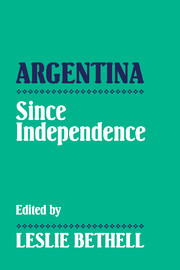Book contents
- Frontmatter
- Contents
- List of maps
- Preface
- 1 From independence to national organization
- 2 The growth of the Argentine economy, c. 1870–1914
- 3 Society and politics, 1880–1916
- 4 Argentina in 1914: The pampas, the interior, Buenos Aires
- 5 From the First World War to 1930
- 6 Argentina, 1930–1946
- 7 Argentina since 1946
- Bibliographical essays
- Index
2 - The growth of the Argentine economy, c. 1870–1914
Published online by Cambridge University Press: 09 November 2009
- Frontmatter
- Contents
- List of maps
- Preface
- 1 From independence to national organization
- 2 The growth of the Argentine economy, c. 1870–1914
- 3 Society and politics, 1880–1916
- 4 Argentina in 1914: The pampas, the interior, Buenos Aires
- 5 From the First World War to 1930
- 6 Argentina, 1930–1946
- 7 Argentina since 1946
- Bibliographical essays
- Index
Summary
A traveller arriving in the Río de la Plata region in the 1870s would have been struck first by the width of the estuary and then, on entering the port of Buenos Aires, by the lowness and simplicity of the buildings. Travelling inland, he would have been stunned by the vast expanses of flat, treeless land, the pampas, stretching away as far as the eye could see, where the overwhelming sense of solitude was only interrupted by the sight of a herd of cattle, or by the sudden appearance of an ostrich or some other example of the local fauna. At that time, the most important commercial activity was carried on in a coastal strip along the estuary of the Río de la Plata and the Paraná, and along the southern course of the river Uruguay in its navigable reaches. The shortage of wood, in addition to the huge distances, was an obstacle to the establishment of permanent settlements inland: prospective settlers were obliged to transport building materials from distant ports or urban areas. Apart from the Paraná, a section of the Uruguay, and the Río Negro, which was in territory still occupied by the Indians, the rivers of Argentina were not navigable, and railways were only just beginning to be built. Moreover, Indians still occupied what was called the ‘desert’, not far beyond the populated areas of Buenos Aires and Santa Fe provinces, and Indian raids were common.
- Type
- Chapter
- Information
- Argentina since Independence , pp. 47 - 78Publisher: Cambridge University PressPrint publication year: 1993
- 11
- Cited by



